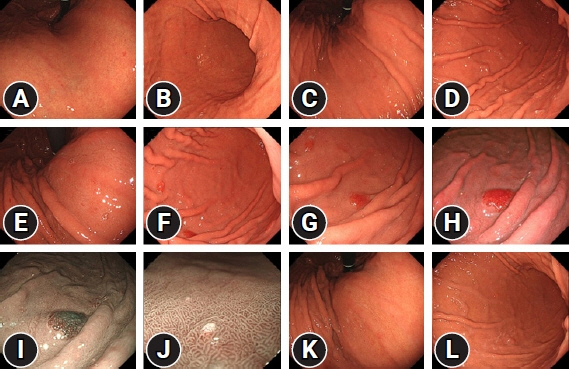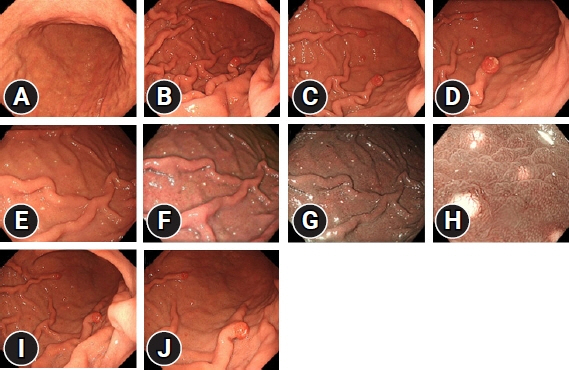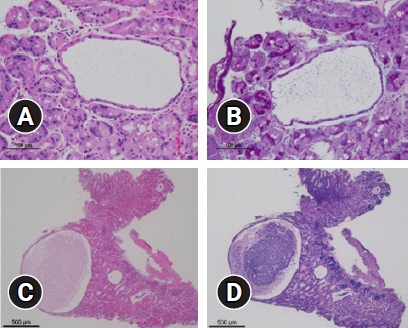Clin Endosc.
2024 Jul;57(4):549-551. 10.5946/ce.2023.186.
Long-term follow-up of patients developing gastric mucosal lesions after initiating the potassium-competitive acid blocker vonoprazan
- Affiliations
-
- 1Department of Gastroenterology, National Hospital Organization Hakodate National Hospital, Hakodate, Japan
- 2Department of Pathology, National Hospital Organization Hakodate National Hospital, Hakodate, Japan
- KMID: 2558114
- DOI: http://doi.org/10.5946/ce.2023.186
Figure
Reference
-
1. Arikawa Y, Nishida H, Kurasawa O, et al. Discovery of a novel pyrrole derivative 1-[5-(2-fluorophenyl)-1-(pyridin-3-ylsulfonyl)-1H-pyrrol-3-yl]-N-methylmethanamine fumarate (TAK-438) as a potassium-competitive acid blocker (P-CAB). J Med Chem. 2012; 55:4446–4456.
Article2. Parsons ME, Keeling DJ. Novel approaches to the pharmacological blockade of gastric acid secretion. Expert Opin Investig Drugs. 2005; 14:411–421.
Article3. Matsukawa J, Kogame A, Tagawa Y, et al. Radiographic localization study of a novel potassium-competitive acid blocker, vonoprazan, in the rat gastric mucosa. Dig Dis Sci. 2016; 61:1888–1894.
Article4. Miyamoto S, Matsuno Y, Kato M, et al. Parietal cell protrusions and dilated oxyntic glands from use of vonoprazan. Am J Gastroenterol. 2017; 112:1899–1901.
Article5. Kubo K, Kimura N, Matsuda S, et al. Vonoprazan-associated gastric mucosal redness: a report of four cases. Intern Med. 2020; 59:507–511.
Article6. Kubo K, Kimura N, Watanabe R, et al. Vonoprazan-associated gastric mucosal redness in non-Helicobacter pylori-infected and Helicobacter pylori-eradicated stomach. Case Rep Gastroenterol. 2021; 15:751–758.
Article7. Nishiyama N, Kobara H, Ayaki M, et al. White spot, a novel endoscopic finding, may be associated with acid-suppressing agents and hypergastrinemia. J Clin Med. 2021; 10:2625.8. Yoshizaki T, Morisawa T, Fujinami M, et al. Propensity score matching analysis: incidence and risk factors for "stardust" gastric mucosa, a novel gastric finding potentially induced by vonoprazan. Aliment Pharmacol Ther. 2021; 53:94–102.
Article9. Iwamuro M, Shiraha H, Okada H. Gastric polyps' regression after potassium-competitive acid blocker cessation. J Gen Fam Med. 2022; 23:358–359.
Article10. Goto C, Okimoto K, Matsusaka K, et al. Long-term vonoprazan administration causes gastric fundic gland-type hyperplastic polyps and chronic bleeding. Clin J Gastroenterol. 2023; 16:159–163.
Article
- Full Text Links
- Actions
-
Cited
- CITED
-
- Close
- Share
- Similar articles
-
- Potassium-competitive acid blocker-associated gastric mucosal lesions
- Role of Acid Suppression in Acid-related Diseases: Proton Pump Inhibitor and Potassium-competitive Acid Blocker
- Potent Potassium-competitive Acid Blockers: A New Era for the Treatment of Acid-related Diseases
- Pathophysiology of Potassium-competitive Acid Blocker–refractory Gastroesophageal Reflux and the Potential of Potassium-competitive Acid Blocker Test
- Treatment of Acid-related Diseases Using Potassium-competitive Acid Blockers




